 |
||
|
||
| ||
Not so long ago we spoke about a video card on NVIDIA GeForce2 Ultra chipset - Creative 3D Blaster Annihilator2 Ultra - the first specimen of the family of the most efficient graphics accelerators at the end by 2000. That time we analyzed the situation on the video card market and first of all in the segment took by graphics accelerators from NVIDIA. That's why today we won't talk much about it. In this review I want to introduce another video card based on GeForce2 Ultra, it is ASUS AGP-V7700 Ultra. This board belongs to High-End class and is intended for hardcore gamers. Its price corresponds to the high level as well. This ASUS AGP-V7700 Ultra will help you to broaden your knowledge on GeForce2 Ultra based cards, especially since today many vendors don't develop their own PCB design and just use ready-made schemes from NVIDIA. Besides, NVIDIA has already been shipping their graphics processors together with memory to vendors for a long time, that's why the cards on chips from NVIDIA of different manufacturers don't differ at all. On the other hand it ensures practically 100% guarantee for high quality of all these cards. Nevertheless, it's always interesting to look at a new product from such a famous manufacturer, moreover, the mass sales of ASUS AGP-V7700 Ultra are just about to start. SpecificationOK, here is specification of GPU NVIDIA GeForce2 Ultra: 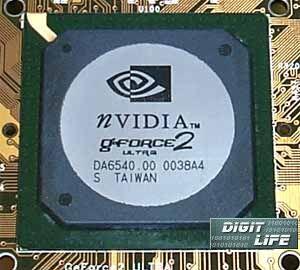
3D graphics:
Video:
Board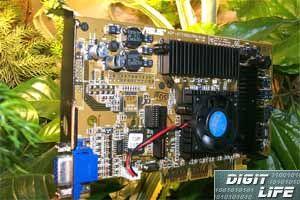 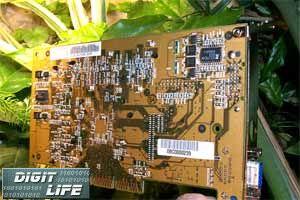 First of all, ASUS AGP-V7700 Ultra is a series card from ASUSTeK. The card possesses AGP x2/x4 interface, 64 MBytes DDR SDRAM located in 8 chips on the right side of PCB. 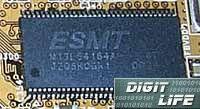 The memory chips have cooling radiators which are mounted to the PCB, that's why we can uninstall them and see that the memory modules are ESMT 4ns from EliteMT company. It is rather fast memory that is able to operate at the regular frequency of 250 MHz (or at the effective one of 500 MHz). But the frequency was set to 230 MHz in order to provide high reliability. We can see that today this frequency is an upper limit for memory working speed of DDR class. OverclockingNevertheless, we managed to make the memory work stable at 250 MHz (500MHz) with ASUS AGP-V7700 Ultra. Further overclocking was impossible because of blocking in drivers, since with the frequency increase the system would have buzzed. The graphics core operated steady up to 300 MHz (at 310 MHz it revealed some unstability). FeaturesThe card has a jack for connecting a daughter board with TV-out. Such solution allows to realize a universal connector for daughter boards with TV-out, TV-in or TV-in/out. So, video card manufacturers can produce different modification without changing the reference design, including a whole multimedia combine. In this case the connector is not used. The graphics processor is locked up with the radiator on PCB with an active cooler. The video card is supplied in retail-package. The complete set includes the board itself, installation manual and several CDs:
Installation and driversTogether with the video card we have received drivers from ASUSTeK of 6.31beta5 version, which are based on the reference ones from NVIDIA of the same version 6.31. PerformanceFor our tests we assembled the following testbed:
Note that the tests were carried out with the disabled Vsync. For you to compare we have included the results of the video cards based on GeForce2 GTS 64 MBytes - Inno3D Tornado GeForce2 GTS/64, on the base of GeForce2 GTS 32 MBytes - Aopen PA256 Deluxe, GeForce2 MX - reference card NVIDIA GeForce2 MX 32 MBytes, and GeForce2 Pro - Leadtek WinFast GeForce2 Pro. Let's look at 2D-graphics. The GeForce2 Ultra based cards work at the speeds very similar to GeForce2 GTS based cards which we considered earlier. In principle, further speed increase of the game card in 2D makes no sense, since the latest video cards work rather fast. As for 2D quality, I have something to say here. In general, quality in 2D is quite decent. It operates perfectly at 1600X1200 on ViewSonic P817. Note that I tested only one sample, so you shouldn't generalize the results for all GeForce2 Ultra based boards, especially considering some issues in the Net on the problems in 2D connected with the cards from Creative and Hercules based on GeForce2 Ultra5. Those cards had some horizontal waves when working at some resolutions and at definite frame rates. How was this quality reached? At the first look, RAMDAC does have 350 MHz frequency, identical to NVIDIA GeForce 256, but the difference still exists. The first fact that caused quality enhancement is probably that in this chip NVIDIA uses a completely new RAMDAC, which is not integrated in the graphics core itself, though it's located in the same case. But in my opinion a more simplistic explanation to that lies in carrying of a connector of TV-out from the main PCB to the daughter board. Now comes an estimation of the card's performance in 3D. The following programs will help us to do it:
Quake3 ArenaThe test on the standard demo002 was carried out in two modes: Fast (shows card's work in 16-bit color) and High Quality (shows card's work in 32-bit color). 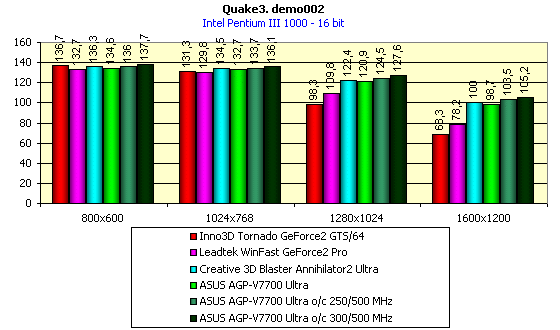  The results were expectable. High speed increase, as compared with the competitors, provides for good gameability even at 1600X1200X32, though at some resolutions ASUS AGP-V7700 Ultra showed lower performance than its predecessor Creative 3D Blaster Annihilator2 Ultra. Interestingly that speed increase while overclocking is not so solid because 500 MHz of memory is not enough for 250 MHz graphics core. The test on Quaver was implemented in two modes as well: 16-bit and 32-bit color. In both cases we used maximum quality settings (trilinear filtering, maximum level of geometry detailing, texture quality was set to 4). 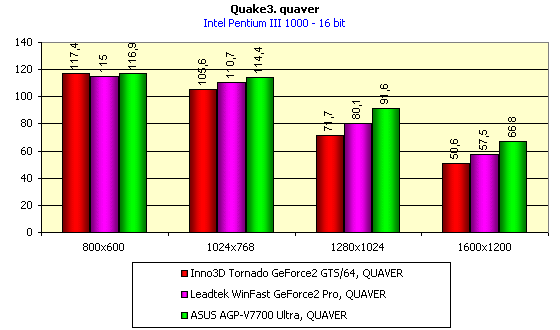 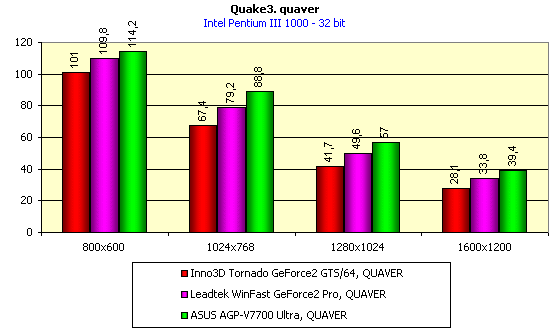 This benchmark uses a level with large textures (q3dm9), so it was very interesting just to show how the most powerful video accelerators manage to do it. Sure, the gameability in 1600X1200X32 is under an acceptable level, however the lower resolution in 32bit color ensures comfort while playing. When I considered the first 64 MBytes card on GeForce2 GTS I wrote that when at the level where large textures are used such local memory size gives out a positive effect. That's why with the increase of graphics core power and memory speed (or bandwidth) the gap between 64 MBytes cards and 32 MBytes analogs will grow wider as far as performance is concerned. First of all we mean games (or levels) where the majority of textures are of 512X512 or higher. All this proves the solution on installation of exactly 64 MBytes local memory on GeForce2 Pro and GeForce2 Ultra based boards. ExpendableWe will use this game to show the card's speed in Direct3D. 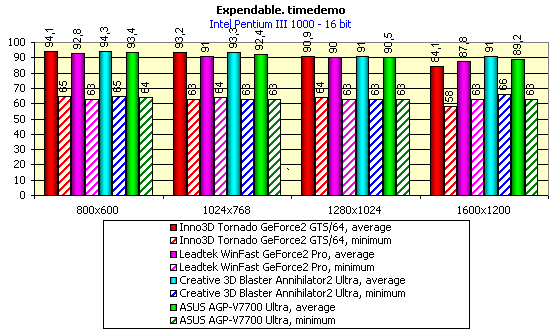 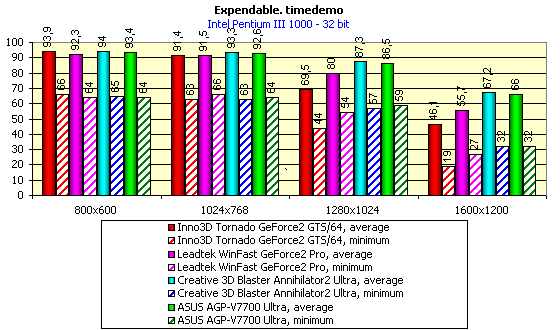 The results show that in 16-bit color the card performance gets stuck against the CPU frequency, and even 1 GHz processor power is not enough for realization of GeForce2 Ultra. The game possibilities are very high. Crytek X-IsleThis test based on the newest engine from Crytek shows us all latest enhancements from NVIDIA in the field of 3D-graphics. In the test there are a lot of objects in the scene, each consisting of great number of polygons. That's why the complicity of the game is very high. And with it we can see high realistic graphics.   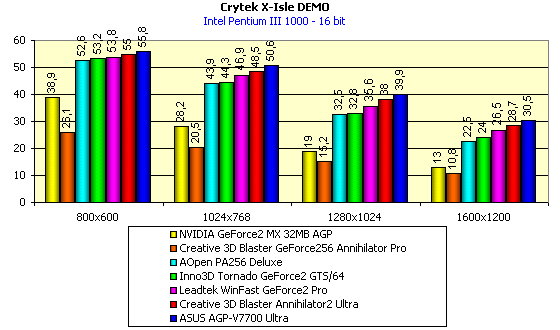 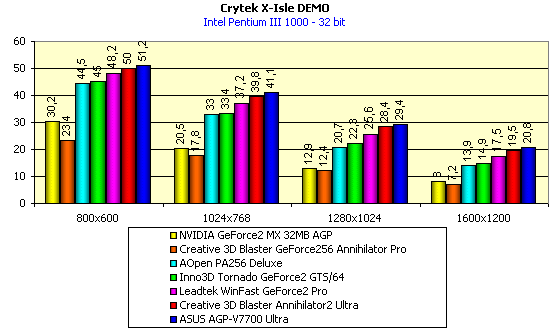 So, you can see that even the most powerful accelerators can't cope with it. GPU GeForce256 DDR is something like RivaTNT (that is it's an accelerator of the start level) regarding modern cards. Besides, you might know that the card on GeForce2 MX with the less efficiency than the board on GeForce256 DDR in most games was the last to lose. But in this case the board on GeForce2 MX turned to be the first. It's likely that it happened at the expense of more powerful Hardware T&L block and thanks to the better optimization of the graphics core with support of all latest innovations in 3D-graphics. Besides, if in Quake3 the video card ASUS AGP-V7700 Ultra lagged behind Creative 3D Blaster Annihilator2 Ultra by a little margin, in this test it's vice versa - the card from ASUS turned to be the best. However, in both cases the difference is very insignificant - not more than 1-2%. Well, I should make a conclusion that the market of modern videocards is not ready for such games (not so many users possess accelerators of GeForce2 GTS level and higher). We should wait more than a year for the current expensive cards to fall down to $100, and only then we will be able to see the games with almost photoreal graphics. Of cause such games will be appearing all the time, but their mass sales won't be so soon. Finishing with the performance of NVIDIA GeForce2 Ultra, I want to stress on the following:
More about quality in 3D-graphicsIn general the quality is just perfect! There you can see a full work of trilinear filtering, anisotropic filtering, S3TC support what allows you to see marvelous scenes with detailed objects (at special levels). There is one problem with texture compression method in 32 bit color with S3TC in use in autocompression mode (in Quake3 on the regular levels with enabled S3TC there comes compression of usual textures with the following unpack in automatic mode). NVIDIA has an error in the algorithm of unpack, when with 32-bit graphics we received 16-bit texels after unpack, and consequently the sky was covered with scraps. Though, we found a way of reduction of this artifact. Additional featuresOf cause, many of you are interested in the work of new cards from the point of view of DVD-video support. I have already noticed that NVIDIA GeForce256/GeForce2 chips offer a full support for Motion Compensation when decoding MPEG2-stream. All modern soft DVD players are supported by GeForce256/GeForce2 chipsets, that's why you can easily get a good quality level of video playback together with a low CPU load. The ASUS AGP-V7700 Ultra card is equipped with ASUS DVD 2000 player which is based on a popular PowerDVD v.2.5. After optimization of all functions under NVIDIA GeForce2 the image on NVIDIA GeForce2 Ultra was fairy-tale. And the processor's load constituted only 21-23% ! ConclusionNVIDIA has released the most powerful graphics accelerator with a huge number of advantages. ASUSTeK company was first to release a video card on this chip which entirely corresponds to High-End class in the segment of game videocards. Undoubtedly, the working speed of this card in 3D is fabulous when working with modern games. If you are not a budget-conscious man, you can get it at $450. Isn't it overprice for this 3D accelerator? You understand that GeForce2 Ultra based cards are not intended for the mass market, so the price is appropriate (besides, there is no any other competitors). Furthermore, there is some shortage of memory that works at 250 MHz. NVIDIA itself positions GeForce2 Ultra as High-End solution, so it's not affordable for the majority. Otherwise, NVIDIA offers the products within different price ranges, and you can choose not so expensive cards based on Pro, GTS or MX. Today I advise to buy GeForce2 Ultra based cards only for those who can afford it really. Otherwise, get the boards on GeForce2 Pro, or at least wait until the New Year, when the prices should fall at least to $300. Highs:
Lows:
Write a comment below. No registration needed!
|
Platform · Video · Multimedia · Mobile · Other || About us & Privacy policy · Twitter · Facebook Copyright © Byrds Research & Publishing, Ltd., 1997–2011. All rights reserved. |